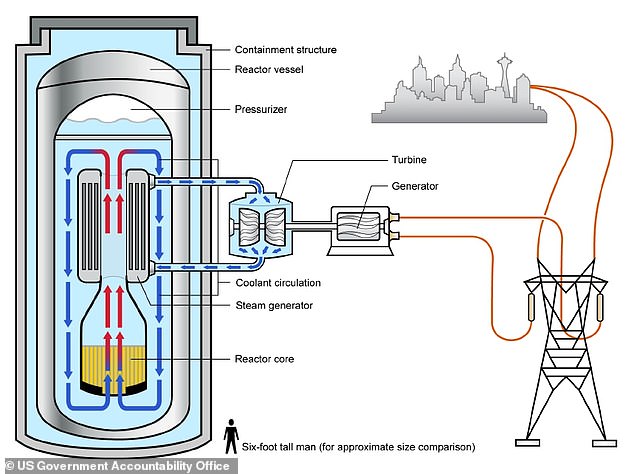Britain’s first ever mini nuclear power station in Wales is set to deliver power to millions of homes within a decade.
The government has announced that three ‘small modular reactors’ (SMRs) will be built at a new power station in Wylfa, on the coast of Anglesey in North Wales.
Designed and made by Rolls-Royce, each small reactor will deliver enough power for 1 million homes, or 3 million in total, for at least 60 years.
An artist impression from the company shows a bizarre rectangular design for the facility, which will roughly cover the size of two football pitches.
Wylfa, the site of an old nuclear power station that closed down in 2015, will be supplying power to the grid from the mid-2030s and become a ‘beacon’ of a nuclear golden age.
Simon Bowen, chair of government company Great British Energy-Nuclear, called the announcement a ‘historic moment for the UK’.
‘Wylfa has a proud history of nuclear excellence, and we’re excited to build on that foundation to deliver jobs, training, and low-carbon energy for generations to come,’ he said.
Nuclear power is touted as a safe, clean and sustainable energy source that can meet the world’s energy needs, but crucially SMRs are generally more practical build than larger, more traditional nuclear power stations.

The power plant, roughly the size of two football pitches, will be supplying power to the grid from the mid-2030s, the government hopes. Pictured, the latest artist’s impression

Illustration of a small modular nuclear reactor (SMR). These smaller nuclear reactors that have a power capacity of up to 300 MW(e) per unit, which is about one-third of the generating capacity of traditional nuclear power reactors
Just like larger conventional reactors already in use around the world, SMRs create energy by forcing radioactive elements to undergo a process called fission.
During this process, the element breaks down into smaller, more stable elements and releases heat which can be used to drive steam turbines, in turn producing electricity.
As the name suggests, small modular reactors (SMRs) are designed to be built in a factory and then shipped to sites for installation.
They’re allegedly quicker and cheaper to build than more traditional plants such as Hinkley Point C, a nuclear power station under construction in Somerset.
By allocating £2.5 billion in funding to this project, the government is pinning its hopes on SMRs, which are defined as having a power capacity of 300 megawatts, about a third of the generating capacity of the traditional ones.
However, critics believe SMRs will be unduly expensive because they may not be able to achieve the economy of scale of larger plants.
What’s more, there’s still controversy surrounding nuclear’s status as a planet-friendly energy source compared with solar and wind.
Nuclear energy itself is renewable, but the material used in fission reactions – uranium – is a non-renewable and mined from the ground.

The government has announced that three small modular reactors (SMRs) will be located in Wylfa, on the coast of Anglesey, Wales. Wylfa is the site of an old nuclear power station that closed down in 2015 (pictured)
In addition, SMRs will likely produce long-lasting nuclear waste – primarily spent uranium fuel, considered radioactive and hazardous for a long time.
Ed Lyman, director of nuclear power safety at the Union of Concerned Scientists, said the ‘hype surrounding SMRs is way overblown’.
They are ‘not more economical than large reactors’, ‘not generally safer or more secure’, and will ‘not reduce the problem of what to do with radioactive waste’, he added.
‘SMRs are distinct from today’s conventional nuclear plants, which are typically around 1,000 megawatts and were largely custom-built,’ Lyman said.
‘Just like today’s nuclear plants, SMRs will be vulnerable to extreme weather events or other disasters that could cause a loss of offsite power and force them to shut down.
‘Since there is virtually no experience with operating SMRs worldwide, it is highly doubtful that the novel designs being pitched now would be highly reliable right out of the box.’
Elsewhere, SMRs are currently under construction is in China and Russia, while in the US a company called TerraPower has applied for a permit to build one (although at a planned 345 megawatts, it wouldn’t technically be an SMR, Lyman said).
Google is also backing the construction of seven SMRs from Kairos Power that will supply energy to its data centres, which have vast energy requirements.

It’s hoped SMRs will be quicker to build than more traditional plants such as Hinkley Point C, a nuclear power station under construction in Somerset. Pictured, workers stand near a 245-tonne domed roof being place on the second reactor building at Hinkley Point C, July 17, 2025
The Department for Energy Security and Net Zero (DESNZ) said the project at Wylfa will support up to 3,000 jobs in the local economy at the height of construction.
However, the plans have prompted an angry response from US ambassador Warren Stephens, who is ‘extremely disappointed’ by the decision.
The ambassador had been pushing for a larger reactor at Wylfa, and US firm Westinghouse had reportedly presented plans to the UK government to build a new gigawatt station at the site.
He said: ‘If you want to get shovels in the ground as soon as possible and take a big step in addressing energy prices and availability, there is a different path, and we look forward to decisions soon on large-scale nuclear projects.
‘As I have repeatedly said, we want the UK to be the strongest possible ally to the United States, and high energy costs are an impediment to that.’
